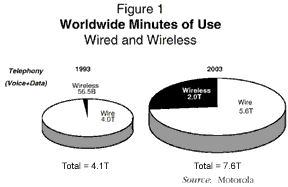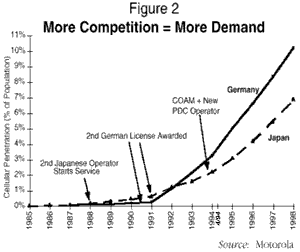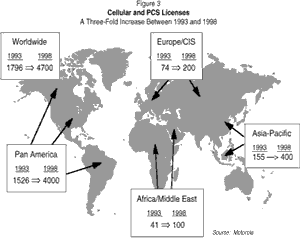
In 1992, there were approximately 56 billion minutes of worldwide use in wireless compared to wire line minutes of use which were four trillion. As seen in Figure 1, it is predicted that, by 2003, the total minutes of telephone use will approach eight trillion and wireless will account for two trillion (25%) of worldwide minutes. That will drive an incredible increase in wireless systems around the world. However, it's more than a simple multiplication story. Rather, it is one that is "wired" with incredible possibilities for both developed and developing nations to establish and expand wireless telecommunications as we know it today.

ACCELERATED WORLDWIDE SUBSCRIBER GROWTH
As we look at the current figures of worldwide subscribers, it is clear that we are in an accelerated growth phase. Just a few years ago, the number of cellular telephone subscribers was growing at a 40% annual rate. Most recently, the number of subscribers has escalated to more than 50 million, growing at a 50% rate. That number of subscribers is expected to increase to more than 450 million subscribers by the year 2004.
Markets which present significant potential for increased penetration rates over the next 10 years include the United States, Japan, China, Germany, France, India, Italy, Great Britain, Russia, Brazil, Mexico, Indonesia, Canada, Spain, and South Korea. Countries like the United States, Japan, Germany, Italy, Great Britain, Canada and South Korea -- which today account for a substantial percentage of worldwide subscribers -- are predicted to add significantly to their subscriber bases. Countries like China, France, Brazil, Mexico, Indonesia, and Spain have just welcomed cellular telephony into their markets and also represent areas of great growth potential. Currently, there is less than 2% cellular penetration worldwide and a strong demand for phone service.
INCREASED EMPHASIS ON FIXED WIRELESS
For developing countries with little or no telephone service, a new focus is on providing basic residential service via cellular technology. In countries such as India, where only 1% of the 900 million people have telephone service today, wireless offers tremendous communication growth opportunities.
One prominent example is fixed wireless in which emerging economies such as India, Indonesia, Malaysia, Sri Lanka, Russia, and China can finally get "in the loop" of emerging telecommunications service. This is accomplished by attaching wireless tails to cable infrastructure to provide wireless telephony from that infrastructure. Used in both rural and urban areas, fixed wireless has been instrumental in providing telephone service in emergency situations and national disasters, as well as more general commercial use. One example of how fixed wireless has been successful in providing needed telephone service is WiLL®, Wireless In the Local Loop, developed by Motorola and used in more than eight nations.
ADOPTION OF DIGITAL TECHNOLOGY
In addition to subscriber growth and a worldwide focus on wireless, another key trend is the adoption of digital technology. The commercial introduction of Time Division Multiple Access (TDMA) and the current trials of Code Division Multiple Access (CDMA) technology have given operators more than just new cellular standards. Digital technology will provide a number of advantages for both the operator and the subscriber, including improved voice quality, fewer dropped calls, better coverage, enhanced privacy, increased network capacity, new messaging features, and wireless data applications.
Only in its gestation, digital technology has already made an incredible impact on the cellular industry. We have seen an explosive growth in the adoption of the European digital standard, Global System for Mobile Communications (GSM), not only in Europe, but also in other parts of the world. For example, in Germany, there are more than twice as many subscribers to digital mobile services as analog subscribers. Overall, GSM is in commercial service supporting approximately four million subscribers in 52 countries worldwide.
And just what has the introduction of digital technology meant to the analog market? Interestingly enough, it has increased penetration of analog-based cellular systems around the world. Every place where digital technology has been introduced, there has been one absolutely predictable result -- more subscribers flock to both the digital and analog technology.
Currently, 90% of cellular subscribers worldwide are served by analog equipment. Most recently, in markets where analog systems perform well, there were surprising increased growth rates, especially in Pan America, Spain, the United Kingdom, and Japan. After GSM digital networks were introduced in the United Kingdom, not only was there increased competition and lower priced service packages, but also a substantial increase in analog growth.
Why the positive impact of digital on analog growth? First, analog works -- and works well. Second, with the introduction of digital, analog providers become very competitive with their pricing, and rates for minutes of cellular use go down. This causes the subscriber population to accelerate at a more rapid pace. Clearly, the more competition, the better.
AGGRESSIVE PRICING AND OPEN ARCHITECTURE
What are the forces behind this competitive pricing? In the cellular industry, one significant influence has been the advent of open architecture standards. Until recently, analog systems were based on proprietary architectures and interfaces between network elements. As a result, operators had little opportunity to integrate the best system elements available, leaving them captive to a single vendor for fulfilling their end-to-end product requirements.
When these proprietary interfaces open up, it is then possible to mix-and-match radio and switch elements from various vendors. The result is incredible competitive pressure on the suppliers leading to aggressive pricing practices for cellular infrastructure.
Driven by the adoption of GSM, open architecture standards are in place in Europe and more than 50 countries around the world. Figure 2 highlights cellular penetration in Japan and Germany. As illustrated, when you introduce a new competitor, you create more demand among the population. Germany, which grew slowly for a long time because of their outdated system, had reached their subscriber capacity of one million and was impacted by high prices from one cellular equipment provider. This scenario quickly changed when two GSM providers were introduced in the country. The result is an established competitive environment and heightened cellular growth.

OPERATOR CONSOLIDATION
If you look around in the telecommunications industry today, in addition to a competitive stance, you will see operator consolidation. This progression toward centralization of operations is driven, in part, by the demand for seamless wireless service in which a cellular subscriber can make a telephone call from anywhere in the world and by the development of the economies of scale required to compete.
There are a number of examples of this operator consolidation that span the globe. One such scenario is two cellular operators teaming up to offer service in a more expansive area. Or perhaps you've seen the consolidation of a local exchange carrier with an interexchange carrier (IXC) and even a cable company with a local exchange carrier. The merging of such companies contributes to upgraded service for subscribers, more expansive territory coverage, and accelerated cellular growth for the entire industry.
COUNTRIES EMERGING TO MARKET-DRIVEN ECONOMIES
Across the world today, 80% of the population has recently emerged from controlled economies to market driven economies. Such an environment drives the need for communications significantly higher. This is in contrast to the few remaining countries that operate in a controlled economy in which a central committee plans the production of items and therefore the need for interactive communication is rather minimal.
Now, we have countries, like China with a 1.3 billion population, emerging from being a centrally-controlled economy to a market-driven economy. Today, China has about 15 million phones for 1.3 billion people, slightly more than one phone per 100 people. They have a five-year plan to add approximately 85 million new telephone lines in the country or 5.6 phones per 100 people. In such an environment, wire and wireless telecommunications are absolutely essential to the growth of the country.
RAPID AND EFFECTIVE COMMUNICATIONS AS A NECESSITY TO COMPETE IN TODAY'S WORLD
More and more people are using cellular telephones. For instance, in Buenos Aires, 95% of subscribers' telephones are wireless. A significant percentage of people using mobile communications systems today do so to give themselves an edge in conducting their business. There is an underlying presence that says wireless communications will allow you to operate and be an effective and competitive force in today's world. Telephone service is more than just an appeal by many to be kept "in the loop," but rather a staple for any country that wants to upgrade its competitive standing in today's information-driven world.
ALLOCATION OF SPECTRUM FOR WIRELESS SYSTEMS
Another key driving force behind the future of wireless telecommunications is Personal Communications Services (PCS) which combines wireless voice and data service. In the United States alone, the FCC has set aside 140 MHz of spectrum for PCS 1900 MHz and recently (1994) began auctioning licenses for PCS.
This allocation of new spectrum for wireless service is more than a story about MHz or a particular frequency. It's about bandwidth available for new and additional services. PCS allows for new competitors to enter the market, and that inevitably drives down prices and creates demand for new products and services.
It is estimated that, by 1998, there will be 25 million PCS subscribers worldwide. This significant growth is based upon the expected three-fold increase in cellular and PCS licenses from the 1993 figures of approximately 1,800 licenses to a projected 4,700 in 1998 (see Figure 3).

MONOPOLIES GIVING WAY TO TRUE COMPETITIVE MARKET
In this movement toward a wireless world, monopoly is no longer the popular board game. Instead, we are part of a worldwide drive toward a competitive environment that spurs aggressive pricing and product development in the cellular industry. We see new alliances being formed almost daily, especially in the United States where there is considerable competitive activity in telecommunications.
In other countries, such as the United Kingdom, Germany, France, and China, we are seeing the telecommunications monopolies break up through the division of adjunct services from the core business. In addition, the core businesses are starting to become decentralized and fragmented. As monopolies continue to break down, the result is more and more competition in every dimension of the telecommunications business. That means equipment providers will work to deliver new and advanced services for operators and subscribers.
There's more than just talk about open architecture in the cellular industry! Elements of open architecture are in place, including standards such as GSM, Intersystem Operations (IS-41), and A Interface (IS-634), all of which support the beginning of a Wireless Intelligent Network.
GSM digital technology has been introduced in Europe, the Middle East, Asia, and Africa under an open network architecture. As the GSM experience to date has demonstrated, these defined benefits of open architecture can be realized in the industry. In Europe, where the standardized GSM A Interface is in use, the result has been consistently lower infrastructure prices.
Progress in open infrastructure standards in non-GSM markets has, to date, been limited. One of the most notable advances is the introduction of the IS-41 specification which permits subscribers on one vendor's infrastructure system to roam to another. The IS-41 platform is now being offered more often by equipment suppliers deploying cellular networks that are based on analog technology. The defined roaming capability of IS-41 has opened up the lines of communication not only for the subscriber, but also the operator and supplier.
IS-41 is an important first step in moving toward open architecture for the Advanced Mobile Phone Service (AMPS) analog standard. Yet, there is another concept that is getting considerable attention in today's industry. Standardization of the A Interface yields additional benefits for the quest to create a worldwide open network architecture for cellular systems. The proposed A Interface (IS-634) standard is based on the European GSM A Interface and modified to support wireless air interfaces in the Americas. IS-634 defines the essential messaging between the Mobile Telephone Switching Office (MTSO) and the RF subsystem for both cellular and PCS applications. IS-634 is scheduled for balloting by the U.S. Telecommunications Industry Association (TIA) in March 1995.
In the quest for an open, competitive network, there is another important factor emerging -- the Wireless Intelligent Network. Supported by the described open architecture standards, Wireless Intelligent Network is an evolution in the cellular industry that promises faster and more flexible service delivery. It extends "open" cellular concepts beyond the cell site to the switch interface. By moving call processing functions out of the mobile switching center and onto linked Intelligent Network computer platforms, the growing needs of the wireless user for advanced services can be more quickly addressed.
Looking into the future, the greatest success in the Wireless Intelligent Network will come to those who can swiftly create, integrate, and deploy new voice, data, video, and multimedia features and services which customers demand. In the next few years, the evolution of Intelligent Network Personal Services will deliver news memos, stock memos, fax displays, fax notification, and other services over the cellular network.
With open network architecture and advancements in wireless technology leading the way, the cellular industry is transmitting revolutionary messages. As discussed, the status of the wireless telecommunications industry today reflects a period of accelerated worldwide subscriber growth, increased emphasis on fixed wireless systems, adoption of digital technology, aggressive pricing, and worldwide consolidation of operators. It's an exciting time of worldwide cellular penetration, advanced technology, and competition. It's an ever-changing environment that has opened the door to great prospects for the future of cellular. What is the scenario for the future of the wireless world? The following is a sampling of what we may expect.
In addition to open architecture, the allocation of new spectrum for wireless service will spur tremendous growth in the industry. As companies compete for PCS licenses, we will see an environment of increased user demand and constructive competition among suppliers to deliver new services and advanced features for wireless telephony.
In order to compete in the growing cellular market, equipment suppliers will need to direct their efforts toward technology. Wireless technology has taken giant leaps in the last decade, yet there is more that lies ahead in the quest for ubiquitous wireless communications. Digital technology is poised to improve the quality of cellular service that operators can provide subscribers, while also increasing the network capacity and spurring subscriber growth worldwide. With TDMA system deployment on the rise and CDMA trials taking place on an international level, the challenge lies with suppliers to demonstrate the advantages of digital over analog.
In addition to a focus on digital technology, fixed wireless systems have already demonstrated tremendous progress in communications for residents of many developing countries who had little or no phone service. Fixed wireless will remain an integral part in driving the overall growth of the wireless telecommunications industry.
Without a doubt, our need to communicate will continue to play an ever encompassing role in an information-driven world. It is this worldwide need that will place wireless communications in the forefront of the expansive telecommunications industry and advanced technology as the enabler for the next leap. As the percentage of worldwide telephone minutes used shifts from wire to wireless, the overall impact will be an escalated penetration of phone service around the world.
Today, according to Northern Business Information, only 15% to 20% of the world's population has adequate phone service. Assuming that India and China meet their aggressive telecommunications growth plans, it is predicted that 50% to 60% of people around the globe will know first-hand the conveniences and advantages of phone service by the year 2004!